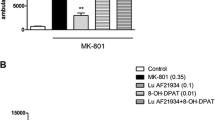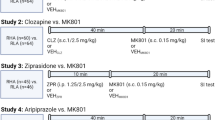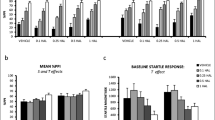Abstract
Rationale
We evaluated locomotor hyperactivity induced in BALB/C mice by an N-methyl-d-aspartate receptor antagonist MK-801 as an assay for the detection of antipsychotic drugs.
Objectives
We assessed the effects of antipsychotic drugs to validate the assay (study 1), selective dopamine and serotonin ligands for pharmacological characterisation of the model (study 2) and a number of compounds with efficacy in models of schizophrenia to understand the predictive validity of the model (study 3).
Methods
Adult males (n = 9/group) were pretreated with a test compound, habituated to locomotor activity cages before receiving MK-801 (0.32 mg/kg) and activity recorded for a further 75 or 120 min. In study 1, we tested haloperidol, clozapine, olanzapine, risperidone, ziprasidone, aripiprazole, sertindole and quetiapine. In study 2, we tested SCH23390 (D1 antagonist), sulpiride (D2/D3 antagonist), raclopride (D2/D3 antagonist), SB-277011 (D3 antagonist), L-745,870 (D4 antagonist), WAY100635 (5-HT1A antagonist), 8-OH-DPAT (5-HT1A agonist), ketanserin (5-HT2A/5-HT2C antagonist) and SB-242084 (5-HT2C antagonist). In study 3, we tested xanomeline (M1/M4 receptor agonist), LY379268 (mGluR2/3 receptor agonist), diazepam (GABAA modulator) and thioperamide (H3 receptor antagonist).
Results
All antipsychotics suppressed MK-801-induced hyperactivity in a dose-dependent and specific manner. The effects of antipsychotics appear to be mediated via dopamine D1, D2 and 5-HT2 receptors. Xanomeline, LY379268 and diazepam were active in this assay while thioperamide was not.
Conclusions
MK-801-induced hyperactivity in BALB/C mice model of positive symptoms has shown predictive validity with novel compounds acing at M1/M4, mGluR2/3 and GABAA receptors and can be used as a screening assay for detection of novel pharmacotherapies targeting those receptors.






Similar content being viewed by others
References
Andiné P, Widermark N, Axelsson R, Nyberg G, Olofsson U, Mårtensson SM (1999) Characterization of MK-801-induced behaviour as a putative rat model of psychosis. J Pharm Exp Ther 290:1393–1408
Angelucci ME, Vital MA, Cesario C, Zadusky CR, Rosalen PL, Da Cunha C (1999) The effect of caffeine in animal models of learning and memory. Eur J Pharmacol 2–3:135–140
Arrang JM, Garbarg M, Lancelot JC, Lecomte JM, Pollard H, Robba M, Schunack W, Schwartz JC (1987) Highly potent and selective ligands for histamine H3-receptors. Nature 327:117-123
Arrang JM (2007) Histamine and schizophrenia. Int Rev Neurobiol 78:247–287
Bardgett ME, Points M, Roflow J, Blankenship M, Griffith MS (2009) Effects of the H3 antagonist, thioperamide, on behavioural alterations induced by systemic MK-801 administration in rats. Psychopharmacology 205:589–597
Boulay D, Bergis O, Avenet P, Griebel G (2010) The glycine transporter-1 inhibitor SSR103800 displays a selective and specific antipsychotic-like profile in normal and transgenic mice. Neuropsychopharmacology 35:416–427
Brabant C, Alleva L, Grisar T, Quertemont E, Lakaye B, Ohtsu H, Lin JS, Jatlow P, Picciotto MR, Tirelli E (2009) Effects of the H(3) receptor inverse agonist thioperamide on cocaine-induced locomotion in mice: role of the histaminergic system and potential pharmacokinetic interactions. Psychopharmacology 202:673–687
Brady AE, Jones CK, Bridges TM, Kennedy JP, Thompson AD, Heiman JU, Breininger ML, Gentry PR, Yin H, Jadhav SB, Shirey JK, Conn PJ, Lindsley CW (2008) Centrally active allosteric potentiators of the M4 muscarinic acetylcholine receptor reverse amphetamine-induced hyperlocomotor activity in rats. J Pharmacol Exp Ther 327:941–953
Butelman ER (1989) A novel NMDA antagonist, MK-801, impairs performance in a hippocampal-dependent spatial learning task. Pharmacol Biochem Behav 34:13–16
Carpenter WT Jr, Buchanan RW, Kirkpatrick B, Breier AF (1999) Diazepam treatment of early signs of exacerbation in schizophrenia. Am J Psychiatry 156:299–303
Cartmell J, Monn JA, Schoepp DD (1999) The metabotropic glutamate 2/3 receptor agonists LY354740 and LY379268 selectively attenuate phencyclidine versus d-amphetamine motor behaviours in rats. J Pharmacol Exp Ther 291:161–170
Cartmell J, Monn JA, Schoepp DD (2000) The mGlu2/3 receptor agonists LY379268 selectively blocks amphetamine ambulations and rearing. Eur J Pharmacol 361:39–46
Castellani S, Adams PM (1981) Acute and chronic phencyclidine effects on locomotor activity, stereotypy and ataxia in rats. Eur J Pharmacol 73:143–154
Chan WY, McKinzie DL, Bose S, Mitchell SN, Witkin JM, Thompson RC, Christopoulos A, Lazareno S, Birdsall NJ, Bymaster FP, Felder CC (2008) Allosteric modulation of the muscarinic M4 receptor as an approach to treating schizophrenia. Proc Natl Acad Sci USA 105:10978–10983
Clapham J, Kilpatrick GJ (1994) Thioperamide, the selective histamine H3 receptor antagonist, attenuates stimulant-induced locomotor activity in the mouse. Eur J Pharmacol 259:107–114
Conn PJ, Lindsley CW, Jones CK (2008) Activation of metabotropic glutamate receptors as a novel approach for the treatment of schizophrenia. Cell 30:25–31
Connolly PM, Maxwell C, Liang Y, Kahn JB, Kanes SJ, Abel T, Gur RE, Turetsky BI, Siegel SJ (2004) The effects of ketamine vary among inbred mouse strains and mimic schizophrenia for the P80, but not P20 or N40 auditory ERP components. Neurochem Res 29:1179–1188
Corbett R, Camacho F, Woods AT, Kerman LL, Fishkin RJ, Brooks K, Dunn RW (1995) Antipsychotic agents antagonise non-competitive N-methyl-D-aspartate antagonist-induced behaviours. Psychopharmacology 120:67–74
Coyle JT (1996) The glutamatergic dysfunction hypothesis for schizophrenia. Harv Rev Psychiatry 3:241–253
Curzon P, Decker MW (1998) Effects of phencyclidine (PCP) and (+)MK-801 on sensorimotor gating in CD-1 mice. Prog Neuro-psychopharmacol Biol Psychiatry 22:129–146
Deutsch SI, Rosse RB, Paul SM, Riggs RL, Mastropaolo J (1997) Inbred mouse strains differ in sensitivity to popping elicited by MK-801. Pharmacol Biochem Behav 57:315–317
Deutsch SI, Mastropaolo J, Powell DG, Rosse RB, Bachus SE (1998) Inbread mouse strains differ in their sensitivity to an antiseizure effects of MK-801. Clin Neuropharmacol 21:255–257
Faucard R, Armand V, Héron A, Cochois V, Schwartz JC, Arrang JM (2006) N-methyl-D-aspartate receptor antagonists enhance histamine neuron activity in rodent brain. J Neurochem 98:1487–1496
Ford LM, Norman AB, Sanberg PR (1989) The topography of MK-801-induced locomotor patterns in rats. Physiol Behav 46:755–758
Galici R, Echemendia NG, Rodriguez AL, Conn JP (2005) A selective allosteric potentiator of metabotropic glutamate (mGlu) 2 receptors has effects similar to an orthosteir mGlu2/3 receptor agonist in mouse models predictive of antipsychotic activity. J Pharmacol Exp Ther 315:1181–1187
Guidotti A, Auta J, Davis JM, Dong E, Grayson DR, Veldic M, Zhang X, Costa E (2005) GABAergic dysfunction in schizophrenia: new treatment strategies on the horizon. Psychopharmacology 180:191–205
Hargreaves EL, Cain DP (1992) Hyperactivity hyper-reactivity and sensorimotor deficits induced by low doses of the N-methyl-D-aspartate noncompetitive channel blocker MK801. Behav Brain Res 47:23–33
Heale V, Harley C (1990) MK-801 and AP5 impair acquisition but not retention of the Morris milk maze. Pharmacol Biochem Behav 36:145–149
Iverson SD, Singh L, Oles RJ, Preston C, Tricklebank MD (1988) Psychopharmacological profile of the N-methyl-D-aspartate (NMDA) receptor antagonist, MK-801. In: Domino EF, Kamenka JM (eds) Sigma and phencyclidine-like compounds as molecular probes in biology. NPP Books, Ann Arbor, pp 373–384
Javitt DC, Zukin SR (1991) Recent advances in the phencyclidine model of schizophrenia. Am J Psychiatry 148:1301–1308
Jentsch JD, Roth RH (1999) The neuropsychopharmacology of phencyclidine: from NMDA receptor hypofunction to the dopamine hypothesis of schizophrenia. Neuropsychopharmacology 20:201–225
Jones CK, Brady AE, Davis AA, Xiang Z, Bubser M, Tantawy MN, Kane AS, Bridges TM, Kennedy JP, Bradley SR, Peterson TE, Ansari MS, Baldwin RM, Kessler RM, Deutch AY, Lah JJ, Levey AI, Lindsley CW, Conn PJ (2008a) Novel selective allosteric activator of the M1 muscarinic acetylcholine receptor regulates amyloid processing and produces antipsychotic-like activity in rats. J Neurosci 28:10422–10433
Jones DNC, Gartlon JE, Minassian A, Perry W, Geyer MA (2008b) Developing new drugs for schizophrenia: from animals to the clinic. In: McArthur RA, Borsini F (eds) Animal and translational models for CNS drug discovery, vol 1: psychiatric disorders. Academic, Burlington
Kalinichev M, Bate ST, Coggon SA, Jones DNC (2008) Locomotor reactivity to a novel environment and sensitivity to MK-801 in five strains of mice. Behav Pharmacol 19:71–75
Keok W, Woods JH, Winger GD (1988) MK-801, a proposed noncompetitive antagonist of excitatory amino acid neurotransmission, produces phencyclidine-like behavioural effects in pigeons, rats and rhesus monkeys. J Pharmacol Exp Ther 245:969–974
Kim JS, Kornhuber HH, Schmid-Burgk W, Holzmuller B (1980) Low cerebrospinal fluid glutamate in schizophrenic patients and a new hypothesis on schizophrenia. Neurosci Lett 20:379–382
Kinon B (2009) LY2140023 monohydrate and agonist at the mGlu2/3 receptor for the treatment of schizophrenia. A paper presented at the International Congress on Schizophrenia Research in San Diego.
Kitaichi J, Yamada K, Hasegawa H, Nabeshima T (1994) Effects of risperidone on phencyclidine-induced behaviours: comparison with haloperidol and ritanserin. Jpn J Pharmacol 66:181–189
Krystal JH, D’Souza DC, Karper LP, Bennett A, Abi-Dargham A, Abi-Saab D, Cassello K, Bowers MB Jr, Vegso S, Heninger GR, Charney DS (1999) Interactive effects of subanesthetic ketamine and haloperidol in healthy humans. Psychopharmacology 145:193–204
Large CH (2007) Do NMDA receptor antagonist models of schizophrenia predict the clinical efficacy of antipsychotic drugs? J Psychopharmacol 21:283–301
Leite JV, Guimarães FS, Moreira FA (2008) Aripiprazole, an atypical antipsychotic, prevents the motor hyperactivity induced by psychotomimetics and psychostimulants in mice. Eur J Pharmacol 578:222–227
Leriche L, Schwartz JC, Sokoloff P (2003) The dopamine D3 receptor mediates locomotor hyperactivity induced by NMDA receptor blockade. Neuropharmacology 45:174–181
Manahan-Vaughan D, von Haebler D, Winter C, Juckel G, Heinemann U (2008) A single application of MK801 causes symptoms of acute psychosis, deficits in spatial memory, and impairment of synaptic plasticity in rats. Hippocampus 18:125–134
Mandillo S, Rinaldi A, Oliverio A, Mele A (2003) Repeated administration of phencyclidine, amphetamine and MK-801 selectively impairs spatial learning in mice: a possible model of psychotomimetic drug-induced cognitive deficits. Behav Pharmacol 14:533–544
Maurel-Remy S, Bervoets K, Millan MJ (1995) Blockade of phencyclidine-induced hyperlocomotion by clozapine and MDL 100,907 in rats reflects antagonism of 5-HT2A receptors. Eur J Pharmacol 280:R9-11
Misslin R, Griebel G, Saffroy-Spittler M, Vogel E (1990) Anxiolytic and sedative effects of 5-HT1A ligands, 8-OH-DPAT and MDL 73005EF, in mice. NeuroReport 1:267–270
Moghaddam B, Adams B (1998) Reversal of phencyclidine effects by a group II metabotropic glutamate receptor agonists in rats. Science 281:1349–1352
Morisset S, Pilon C, Tardivel-Lacombe J, Weinstein D, Rostene W, Betancur C, Sokoloff P, Schwartz JC, Arrang JM (2002) Acute and chronic effects of methamphetamine on tele-methylhistamine levels in mouse brain: selective involvement of the D(2) and not D(3) receptor. J Pharmacol Exp Ther 300:621–628
Moser PC, Tricklebank MD, Middlemiss DN, Mir AK, Hibert MF, Fozard JR (1990) Characterization of MDL 73005EF as a 5-HT1A selective ligand and its effects in animal models of anxiety: comparison with buspirone, 8-OH-DPAT and diazepam. Br J Pharmacol 99:343–349
Natesan S, Reckless GE, Barlow KB, Odontiadis J, Nobrega JN, Baker GB, George SR, Mamo D, Kapur S (2008) The antipsychotic potential of l-stepholidine—a naturally occurring dopamine receptor D1 agonist and D2 antagonist. Psychopharmacology 199:275–289
Nilsson M, Carlsson A, Carlsson ML (1997) Glycine and D-serine decrease MK-801-induced hyperactivity in mice. J Neural Transm 104:1195–1205
Ninan I, Kulkarni SK (1999) Preferential inhibition of dizocilpine-induced hyperactivity by olanzapine. Eur J Pharmacol 368:1–7
Nordquist RE, Risterucci C, Moreau JL, von Kienlin M, Künnecke B, Maco M, Freichel C, Riemer C, Spooren W (2008) Effects of aripiprazole/OPC-14597 on motor activity, pharmacological models of psychosis, and brain activity in rats. Neuropharmacol 54:405–416
Olney FW, Farber NB (1995) Glutamate receptor dysfunction and schizophrenia. Arch Gen Psychiatry 52:998–1007
O’Neill MF, Shaw G (1999) Comparison of dopamine receptor antagonists on hyperlocomotion induced by cocaine, amphetamine, MK-801 and the dopamine D1 agonist C-APB in mice. Psychopharmacology 145:237–250
O’Neill MF, Heron-Maxwell CL, Shaw G (1999) 5-HT2 receptor antagonism reduces hyperactivity induced by amphetamine, cocaine, and MK-801 but not D1 agonist C-APB. Pharmacol Biochem Behav 63:237–243
Ouagazzal A, Nieoullon A, Amalric M (1993) Effects of dopamine D1 and D2 receptor blockade on MK-801-induced hyperactivity in rats. Psychopharmacology 111:427–434
Patil S, Zhang L, Martenyi F, Lowe S, Jackson KA, Andreev BV, Avedisova AS, Bardenstein LM, Gurovich IY, Morozova MA, Mosolov SN, Nesnanov NG, Reznik AM, Smulevich AB, Tochilov VA, Johnson BG, Monn JA, Schoepp DD (2007) Activation of mGlu2/3 receptors as a new approach to treat schizophrenia: a randomized phase 2 trial. Nat Med 13:1102–1107
Perera P-Y, Lichy JH, Mastropaolo J, Rosse RB, Deutsch SI (2008) Expression of NR1, NR2A and NR2B NMDA receptor subunits is not altered in the genetically-inbred Balb/c mouse strain with heightened behavioural sensitivity to MK-801, a noncompetitive NMDA antagonist. Eur Neuropsychopharmacol 18:814–819
Powell SB, Young JW, Ong JC, Caron MG, Geyer MA (2008) Atypical antipsychotics clozapine and quetiapine attenuate prepulse inhibition deficits in dopamine transporter knockout mice. Bev Pharmacol 19:562–565
Prell GD, Green JP, Kaufmann CA, Khandelwal JK, Morrishow AM, Kirch DG, Linnoila M, Wyatt RJ (1995) Histamine metabolites in cerebrospinal fluid of patients with chronic schizophrenia: their relationships to levels of other aminergic transmitters and ratings of symptoms. Schizophr Res 14:93–104
Ralph RJ, Paulus MP, Geyer MA (2001) Strain-specific effects of amphetamine on prepulse inhibition and patterns of locomotor behaviour in mice. J Pharmacol Exp Ther 298:148–155
Reavill C, Taylor SG, Wood MD, Ashmeade T, Austin NE, Avenell KY, Boyfield I, Branch CL, Cilia J, Coldwell MC, Hadley MS, Hunter AJ, Jeffrey P, Jewitt F, Johnson CN, Jones DNC, Medhurst AD, Middlemiss DN, Nash DJ, Riley GJ, Routledge C, Stemp G, Thewlis KM, Trail B, Vong AKK, Hagan JJ (2000) Pharmacological actions of a novel high-affinity, and selective human dopamine D3 receptor antagonist, SB-2777011-A. J Pharmacol Exp Ther 294:1154–1165
Saller CF, Salama AI (1993) Seroquel: biochemical profile of a potential atypical antipsychotic. Psychopharmacology 112:285–292
Shannon HE, Rasmussen K, Bymaster FP, Hart JC, Peters SC, Swedberg MD, Jeppesen J, Sheardown MJ, Sauerberg P, Fink-Jensen A (2000) Xanomeline, an M(1)/M(4) prefering muscarinic cholinergic receptor agonist, produces antipsychotic-like activity in rats and mice. Schizophr Res 42:249–259
Shekhar A, Potter WZ, Lightfoot J, Lienemann J, Dubé S, Mallinckrodt C, Bymaster FP, McKinzie DL, Felder CC (2008) Selective muscarinic receptor agonist xanomeline as a novel treatment approach for schizophrenia. Am J Psychiatry 165:1033–1039
Snyder SH (1976) The dopamine hypothesis of schizophrenia: focus on the dopamine receptor. Am J Psychiatr 133:197–202
Söderpalm B, Engel JA (1988) Biphasic effects of clinidine on conflict behaviour: involvement of different alpha-adrenoceptors. Pharmacol Biochem Behav 30:471–477
Spielewoy C, Markou A (2004) Strain-specificity in nicotine attenuation of phencyclidine-induced disruption of prepulse inhibition in mice: relevance to smoking in schizophrenia patients. Behav Genet 34:343–354
Stanhope KJ, Mirza NR, Bickerdike MJ, Bright JL, Harrington NR, Hesselink MB, Kennett GA, Lightowler S, Sheardown MJ, Syed R, Upton RL, Wadsworth G, Weiss SM, Wyatt A (2001) The muscarinic receptor agonist xanomeline has an antipsychotic-like profile in the rat. J Pharmacol Exp Ther 299:782–792
Steinpreis RE (1996) The behavioral and neurochemical effects of phencyclidine in humans and animals: some implications for modelling psychosis. Behav Brain Res 74:45–55
Steinpreis RE, Salamone JD (1993) The role of nucleus accumbens dopamine in the neurochemical and behavioural effects of phencyclidine: a microdialysis and behavioural study. Brain Res 612:263–270
Su YA, Si TM, Zhou DF, Guo CM, Wang XD, Yang Y, Shu L, Liang JH (2007) Risperidone attenuates MK-801-induced hyperlocomotion in mice via the blockade of serotonin 5-HT 2A/2C receptors. Eur J Pharmacol 564:123–130
Southam E, Cilia J, Gartlon JE, Woolley ML, Lacroix LP, Jennings CA, Cluderay JE, Reavill C, Rourke C, Wilson DM, Dawson LA, Medhurst AD, Jones DNC (2009) Preclinical investigation into the antipsychotic potential of the novel histamine H3 receptor antagonist GSK207040. Psychopharmacology 201:483–494
Spooren WPJM, Gasparini F, van der Putten H, Koller M, Nakanishi S, Kuhn R (2000) Lack of effect of LY314582 (a group 2 metabotropic glutamate receptor agonist) on phencyclidine-induced locomotor activity in metabotropic glutamate receptor 2 knockout mice. Eur J Pharmacol 397:R1–R2
Tang X, Orchard SM, Sanford LD (2002) Home cage activity and behavioural performance in inbred and hybrid mice. Behav Brain Res 136:555–569
Toyota H, Dugovic C, Koehl M, Laposky AD, Weber C, Ngo K, Wu Y, Lee DH, Yanai K, Sakurai E, Watanabe T, Liu C, Chen J, Barbier AJ, Turek FW, Fung-Leug WP, Lovenberg TW (2002) Behavioral characterization of mice lacking histamine H(3) receptors. Mol Pharmacol 62:389–397
Tricklebank MD, Singh L, Oles RJ, Preston C, Iverson S (1989) The behavioural effects of MK-801: a comparison with antagonists acting noncompetitively and competitively at the NMDA receptor. Eur J Pharmacol 167:127–135
Varty GB, Walters N, Cohen-Williams M, Carey GJ (2001) Comparison of apomorphine, amphetamine and dizocilpine disruptions of prepulse inhibition in inbred and outbred mice strains. Eur J Pharmacol 424:27–36
Verebey K, Kogan MJ, Mule SJ (1981) Phencyclidine-induced stereotype in rats: effects of methadone, apomorphine, and naloxone. Psychopharmacology 75:44–47
Whishaw IQ, Auer RN (1989) Immediate and long-lasting effects of MK-801 on motor activity spatial navigation in a swimming pool and EEG in the rat. Psychopharmacology 98:500–507
Woolley ML, Pemberton DJ, Bate S, Corti C, Jones DNC (2008) The mGlu2 but not the mGlu3 receptor mediates the actions of the mGluR2/3 agonist, LY379268, in mouse models predictive of antipsychotic activity. Psychopharmacology 196:431–440
Woolley ML, Carter HJ, Gartlon JE, Watson JM, Dawson LA (2009) Attenuation of amphetamine-induced activity by the non-selective muscarinic receptor agonist, xanomeline, is absent in muscarinic M4 receptor knockout mice and attenuated in muscarinic M1 receptor knockout mice. Eur J Pharmacol 603:147–149
Wozniak DF, Olney JW, Kettinger L III, Price M, Miller JP (1990) Behavioural effects of MK-801 in the rat. Psychopharmacology 101:47–56
Yee BK, Chang TDL, Feldon J (2004) The effects of dizocilpine and phencyclidine on prepulse inhibition of the acoustic startle reflex and on prepulse-elicited reactivity in C57BL6 mice. Neuropsychopharmacology 29:1865–1877
Zocci A, Fabbri D, Heidbreder CA (2005) Aripiprazole increases dopamine but not noradrenaline and serotonin levels in the mouse prefrontal cortex. Neurosci Lett 387:157–161
Conflict of interest
None.
Author information
Authors and Affiliations
Corresponding author
Rights and permissions
About this article
Cite this article
Bradford, A.M., Savage, K.M., Jones, D.N.C. et al. Validation and pharmacological characterisation of MK-801-induced locomotor hyperactivity in BALB/C mice as an assay for detection of novel antipsychotics. Psychopharmacology 212, 155–170 (2010). https://doi.org/10.1007/s00213-010-1938-0
Received:
Accepted:
Published:
Issue Date:
DOI: https://doi.org/10.1007/s00213-010-1938-0




